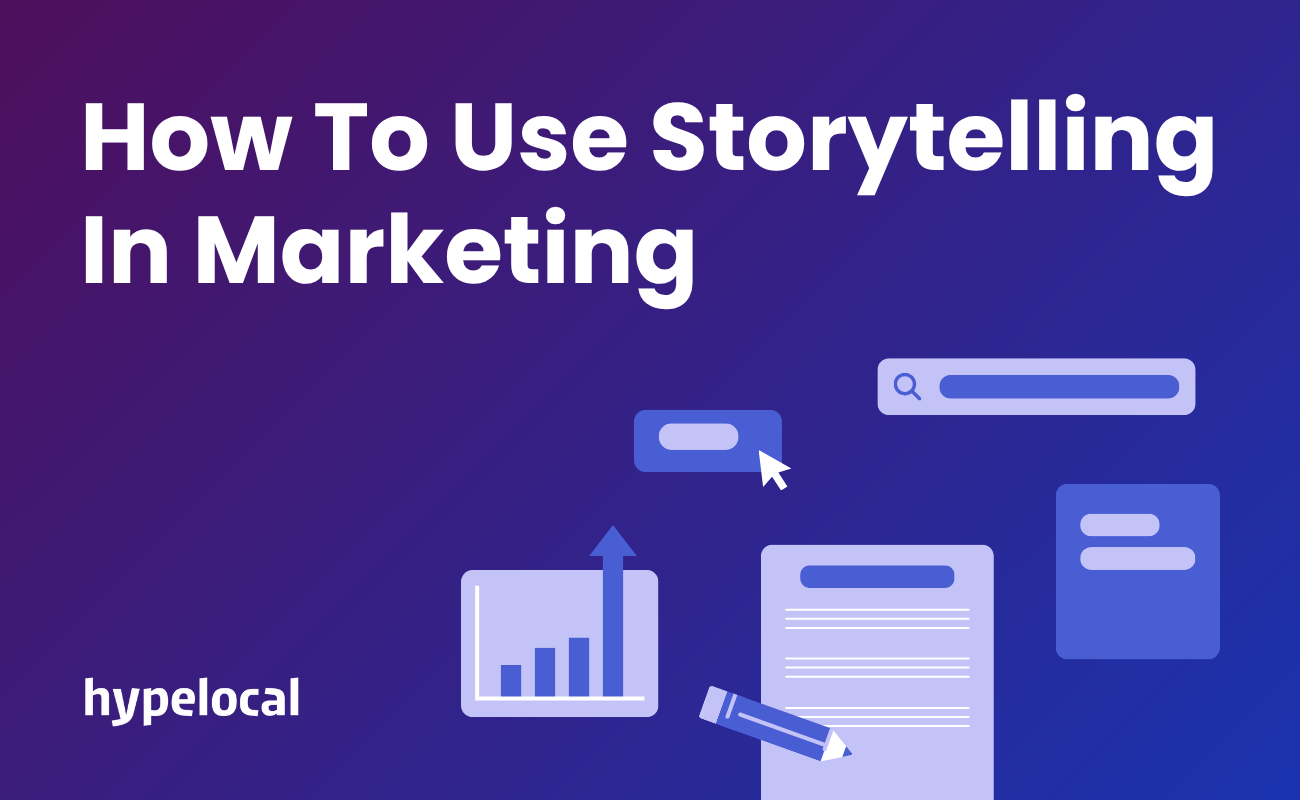
Marketers love to talk about storytelling.
A quick search on LinkedIn for “storytelling” reveals hundreds of thousands of posts, jobs, products, courses, and services.
The problem is, most of what gets said, promoted, and taught about it feels recycled. We’ve all heard the benefits: stories stick, data doesn’t; people buy feelings not features.
All very true. But not very useful on its own.
What most businesses need isn’t another pep talk about storytelling.
They need a framework to actually do it. And they need a way to plug their own brand into that framework so that they can develop messaging that feels sharp, specific, and memorable.
That’s what we’ll cover here.
We’ll walk through a refined version of the Hero’s Journey framework and show you how to turn it into a brand narrative, complete with a ready-to-use ChatGPT prompt to help you build it.
Why Storytelling Works
Storytelling works in marketing because it mirrors how people make decisions.
Customers don’t evaluate features in a vacuum; they imagine what changes if they act, or what happens if they don’t.
Most brand stories miss this because they put the company in the starring role and leave the customer watching from the audience. Or they forget the stakes for their customers, which absolutely drains the tension from a message.
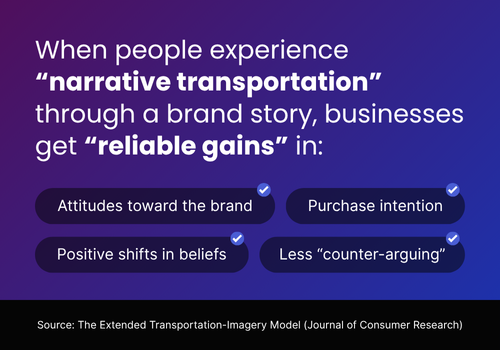
A story without conflict isn’t a story. It’s a brochure.
That’s why it’s so important to adopt a structure that keeps the customer at the center while giving them a clear villain to fight, a guide to follow, and a path to transformation.
The Hero’s Journey, Rewritten for Marketers
The most practical way to structure a brand story borrows from the most common narrative template in existence: The Hero’s Journey.
Popularized by Joseph Campbell, later adapted for screenwriters by Christopher Vogler, and altered again for self-help by Donald Miller, this framework shows up everywhere in our culture.
It’s Frodo carrying the Ring into Mordor, Luke Skywalker taking on the Empire, and Tony Stark’s sacrifice to defeat Thanos.
Different heroes, same rhythm: They want something. They face obstacles to getting it. They find a guide to overcoming those obstacles. They succeed with the guide’s help. They emerge transformed.
From that description, you can likely already imagine its application in marketing.
Every customer is already living their own version of this journey. Your job is to frame it.
The 7-Step Hero Journey Framework for Marketing
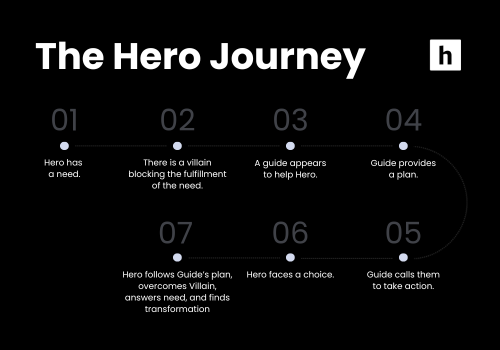
1. Start with the Hero
The hero of the story isn’t your brand. It’s your customer.
They’re the ones with the want, the goal, the itch they can’t scratch.
2. Introduce the Villain
But a want, goal, or itch alone isn’t enough to move them.
Conflict creates momentum.
The villain is the obstacle in their way. It’s the pain point, an external hurdle, the internal frustration it creates, and the larger sense of unfairness that makes the struggle feel wrong.
When you can articulate all of this, you give the story its energy.
3. Step in as the Guide
Your role is the mentor, not the protagonist.
Use empathy to earn attention; authority to earn trust.
You want to convey that 1) you get what they’re going through; and 2) you’ve helped others through this before.
Together, this positions you as the ideal guide, the right partner.
4. Reveal the Plan
Guides don’t just empathize and brag about past exploits.
They show a path forward.
It doesn’t need to be complicated. Providing three or four steps is enough to help the customer picture progress.
“Here is how you get from Point A to Point B.”
5. Tell Them to Take Action
The story has to move forward. And it can’t do that without action.
The plan has been revealed. Now, the hero must take the first step.
It must be clear, visible, and direct.
Some prospects will be ready for the bold ask; others will need a lighter step first. Both should be identified here.
This can also be the moment to address hesitation.
A clear ask paired with a safety net—whether it’s a guarantee, a pilot project, or a simple opt-out—removes friction that leads many potential customers to stall.
6. Raise the Stakes
There’s another way to avoid that stall out: show the stakes involved.
Every story hinges on possibility: What happens if they move forward? What happens if they don’t?
Spell out both the rewards of change and the consequences of inaction.
That’s what makes the decision feel urgent instead of optional.
7. End with Transformation
Finally, show the shift.
Before, the customer felt stuck, uncertain, stretched thin.
Afterwards, they feel capable, confident, in control.
This is the aspirational change at the heart of the hero journey. It’s the ultimate reason why stories persuade in places that feature lists never will.
The Framework in Action
Let’s imagine a hypothetical situation to see how this looks in practice.
Scenario
You run a fitness equipment company.
.png)
For years, customers have bought treadmills, indoor bikes, and weightlifting equipment from you, but the relationship too often ends at checkout.
You launch a fitness tracking companion app because you want recurring revenue and deeper customer loyalty.
Here’s how the Hero’s Journey framework would apply:
Hero
Customers who want to stay consistent with their workouts and finally reach their health goals.
Villain
Distraction and inconsistency.
Externally, life gets in the way. Work and family take priority. Fatigue sets in.
Internally, customers feel a sense of guilt for not meeting their fitness goals.
Philosophically, it feels wrong that someone motivated enough to invest in equipment should feel unsupported in actually using it.
Guide
Your brand steps in with empathy: “We know how hard it is to stay consistent once the initial excitement fades.”
It brings authority: “Thousands of people are already seeing results from our programs.”
Plan
1) Unbox and scan the QR code for instant app access and a free 30-day trial.
2) Take a three-question fitness quiz.
3) Get your first workout scheduled within five minutes.
Action
Direct CTA: “Activate your 30-day trial now.”
Stakes
If they act, they build consistency, see results, and feel supported.
If they don’t, the equipment collects dust, they never get the return they wanted from their purchase and their health goals slip further away.
Transformation
Before, customers feel stuck, guilty, and alone.
Afterwards, they feel confident, motivated, and in control of their fitness journey.
Framework Takeaway: The Cheat Sheet
Here’s a condensed version of the framework to help you keep it top of mind:
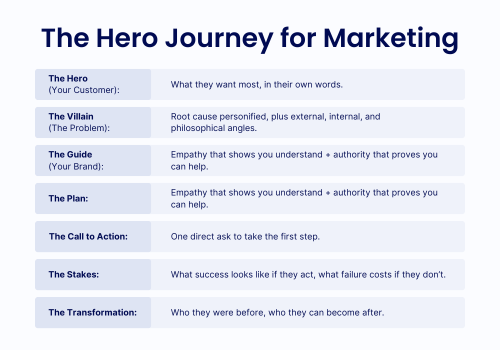
Building Your Story with AI
By now, you’ve seen how the Hero’s Journey applies to marketing and walked through a full example.
But the real value comes when you move from the hypothetical to building your own brand’s story.
This is where AI can help.
Use ChatGPT to map your customer’s journey and draft a brand narrative that follows the framework. All you need to do is plug in details about your audience, product, and goals — and the model will generate a starting point you can refine into messaging.
Here’s the prompt you can copy, paste, and use right away:
You are a senior brand strategist. Build a marketing narrative using a
refined Hero’s Journey for [BRAND].
Context:
- Target Audience: [describe who they are, role, market size]
- Industry/Niche: [SaaS for retail, DTC home goods, B2B services, etc.]
- Product/Service (1 line): [what you help them do]
- Evidence/Proof: [case stats, testimonials, logos, certifications]
- Voice &Tone: [confident, empathetic, direct, witty]
Audience Insights:
- Sales Call Notes: [top objections, repeated pains, exact phrases]
- Support/Reviews Excerpts: [“before/after” quotes, frustrations, delights]
- Search/Community Language: [autocomplete, forum snippets, comments]
Deliverables:
1. Hero: Who the customer is and what they want.
2. Villain &Problems: Root cause, external, internal, philosophical.
3. Guide: 2 empathy statements + 2 authority statements.
4. Plan: A simple 3–4 step process + 2–3 risk-reducing agreements.
5. Calls to Action: 3 direct CTAs + 3 transitional CTAs.
6. Stakes: 3 success outcomes + 3 failure consequences.
7. Transformation: Before (2–3 sentences) and After (2–3 sentences).
Constraints:
- Use clear, human language.
- Keep sentences tight and purposeful.
- Mirror customer language from inputs wherever possible.
The Happy Ending Every Business Needs
Storytelling isn’t about spin.
It’s about giving your customer the role they want to play and showing them how to progress.
The Hero’s Journey gives you the structure, and with the prompt above, you’ve got a way to turn that structure into effective narratives for your business.
Use it, refine it, and give your customers what they want.
Nobody needs another pitch. What we all need is a story worth caring about and a reason to keep turning the page in hopes of a better future.
You may also like

How Hypelocal Won Over An Online Jewellery Retailer With A 937% ROAS
Hypelocal’s ad strategy provided this jewellery retailer with $420K revenue and 937% ROAS.
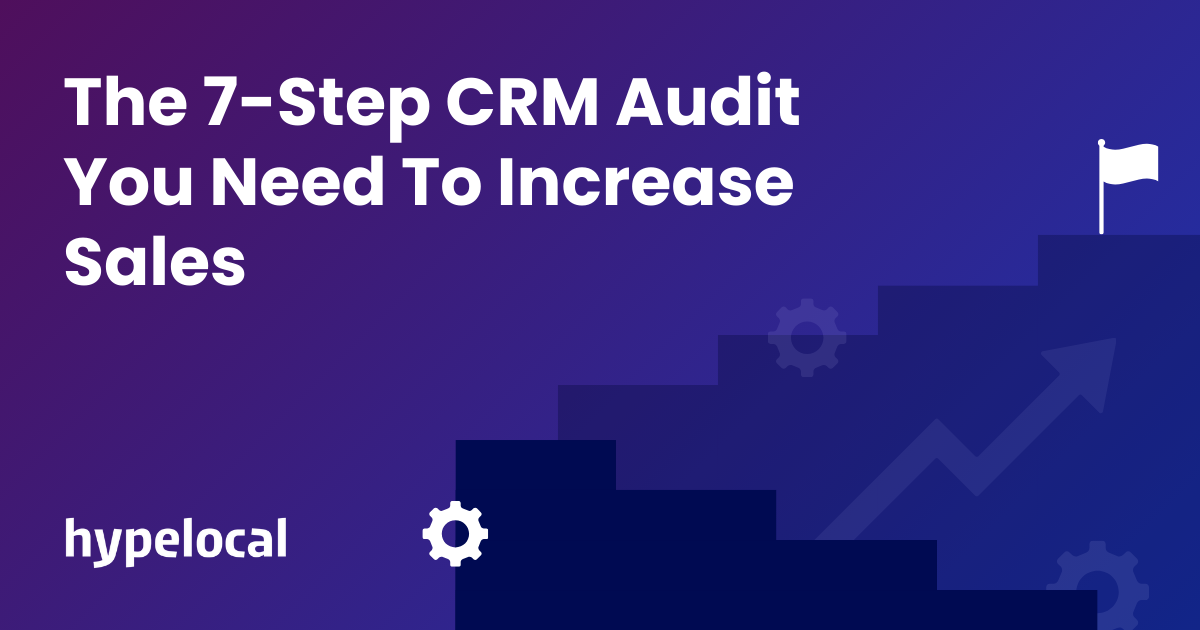
The 7-Step CRM Audit You Need To Increase Sales
Run a 7-step CRM audit to improve sales, clean data, increase adoption, and align teams for stronger growth.



